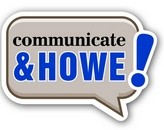The Canadian Public Relations Society defines public relations as:
Public relations is the strategic management of relationships between an organization and its diverse publics, through the use of communication, to achieve mutual understanding, realize organizational goals, and serve the public interest.Flynn, Gregory & Valin, 2008
Public relations (PR) essentially is how you influence what someone thinks of your organization through building a relationship with them. In broad terms, it includes how you reach people with your key messages outside of paid advertising and listen to what they are saying.
Examples include:
- Sponsorships
- Special events
- Speaking engagements
- Media relations (see below)
Public relations is not directly about marketing communications or selling. Rather it is about getting people to think about you and influencing what they think and do. Those efforts may lead to decisions to purchase or donate but that is not the primary objective.
Communicate & Howe! has effectively used public relations to deliver important messages in the past. For example when at the Daily Bread Food Bank in Toronto, James Howe invented the Amazing International Food Race that saw teams of two go around Toronto Amazing Race style to different cultural food stores. The race helped make a couple important points:
- too many newcomers to Canada were using foodbanks despite having advanced education and/or experience as professionals
- food banks needed culturally appropriate foods for users who didn’t grow up on boxed macaroni and cheese
- financial gifts to food banks help them to buy the food that they need the most and use their bulk buying power
Coverage of this event included:
- radio interviews
- TV and newspaper coverage
- e-mails to supporters and encouraging them to resend
- publicized on website
Communicate & Howe! can help use a variety of public relations techniques to help you get the attention you deserve and need.
Media Relations
Getting your organization in the news is one of the best public relations tactics so much so that media relations is often synonymous with PR. For organizations and small businesses looking for the most bang for their buck, getting “unpaid media” is a must because your messages or stories are considered more credible because coming from unbiased third party. A news story about what you are doing also gets you in front of people in a way that you could never afford to buy. As a result, it can work better for you than advertising.
But you need to do it right:
- Your story must be newsworthy to be covered as “hard” news. In other words, why would someone outside of your world care about what you are doing. Is there something truly new, unique, or rare?
- Send out news releases when you have something newsworthy to communicate.
- Only contact the media when you have hard news or you risk the same fate as the boy who cried wolf too often. You risk being ignored when you have something to say.
- Get your news releases into the right hands. Who covers your subject? Which editor is making the decision on story assignments?
But don’t ignore your everyday stories, the media is also looking for good news (also called “soft” news) and what may be commonplace to you is news to many journalists and the general public. Recognize when you have a story that helps to illustrate what you do and why people should care. Charities, non-profits and arts organizations have an advantage to getting coverage because the media truly wants to help you. Work with them by helping them to get what they need and you can benefit from their coverage.
Pricing on news releases:
- $150 for up to one page (recommended) for charities, non-profits, arts organizations & small business // $250 for public sector or medium/large business
- $250 for 2 or more pages for charities, non-profits, arts organizations & small business // $500 for public sector or medium/large business
